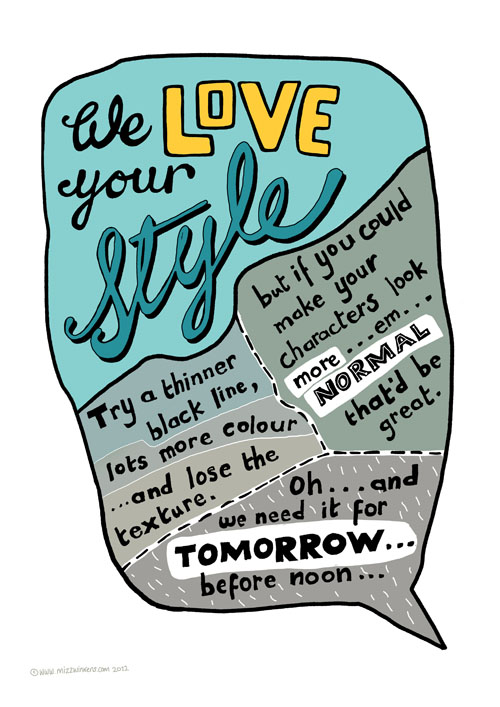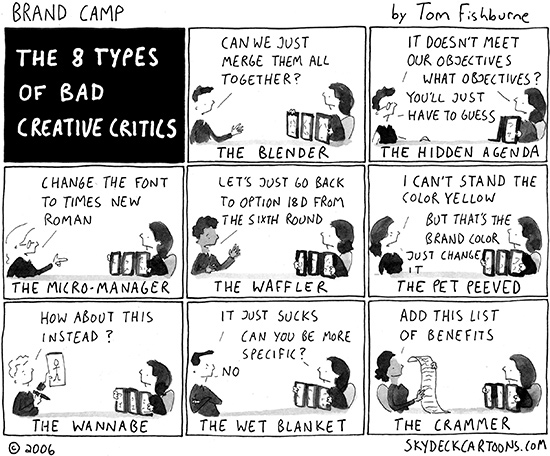
1. Lead with positives
Even in the worst design or copy, there’s usually something worth salvaging. Whether or not it seems that way, everyone’s trying to do their best, and egos can easily get bruised once the feedback starts flowing. Finding a few positives respects the skills and effort of your creative team by pointing out the elements of the project that work. By framing the positive first, you set a more receptive stage for unfavorable feedback. And if you find that there’s nothing salvageable, lead off with acknowledging the time and effort put into the piece.
2. Set the stage
Don’t ambush creatives with drive-by feedback. As tempting as it may be to stop by their desk or pick up the phone, schedule a call or a meeting. Make sure you have your thoughts ready before you walk in the room. The review meeting shouldn’t be your first look at the piece. By scheduling ahead, you also give the creative a chance to mentally prepare instead of being disruptive. Be ready to listen and bring an open mind. Though there might be many stakeholders in the project, strive to keep feedback sessions to 3-6 principals to maintain meeting control.
3. Ask questions first
Before you outright demand a change, make sure to ask your writer or designer to talk you through their intent. Doing creative work is often about making choices between different approaches, so ask them to help you understand why they chose a particular element or structure. By doing this, once again, you’re showing respect to the creative team and the creative process. And if you keep an open mind, you might even realize that an approach that doesn’t initially resonate with you has benefits you didn’t consider. Developing this back and forth will give you more perspective, and it also shows that you’re open to different approaches.

4. Make feedback actionable
Once you’re seeing eye to eye, you can get into your feedback. Start with higher-level observations (like “this doesn’t convey the benefit as strongly as it could” or “I think we need to be clearer about this point”) before you dive into more specific criticism (“the headline seems too small”). Without prescribing specific solutions, unless they’re super obvious, you do need to make sure you’ve given enough for your team to move forward. Identify specific qualities that you find problematic. If you’re having issues getting to the root of what you don’t like, ask for help from other eyes. Or find examples that do what you’re trying to do more successfully. Without specific issues to address, you’re giving vague feedback that forces creatives to read your mind. See the cartoon above for a few examples. 
5. Focus on the work
As you talk through feedback, discuss the work, not the person. “You used the wrong font.” vs. “This looks like the wrong font.” That also applies to you as the feedback giver. The project is not being created to satisfy your personal tastes, but the tastes of your audience. Instead of saying, “I don’t like yellow,” hone in on the impact of the color choice on the intended audience, “This persona may perceive yellow as too informal.” Lean on historical data or industry research that backs up your feedback. “Make the copy under 100 words.” vs. “In our past emails, shorter email copy was more effective. Can we get it under 100 words?”
6. Put all feedback in writing
To save you and your creative team time and headaches, make sure you document your feedback. Even if the feedback was knocked around in an in-person meeting or on a phone call, summarize the interaction via email or in a shared workspace. Not only does it give you a leg to stand on if revisions aren’t addressed, but it also serves as a reference for the creative in case their memory of the conversation fails. Clearly state the next steps and timelines that are expected so everyone knows what to expect.
7. Get everyone’s feedback at the same time
Chances are, different people will see different things. It’s really hard for a creative team to respond to disparate feedback from different sources. And when the feedback isn’t aligned, it can be impossible. When there are several stakeholders, make sure all the feedback flows through one person to keep it consistent and timely. At the end of the day, giving effective feedback is about building a strong working relationship with your creative team. When creatives and marketers communicate well, projects get done faster, there’s more trust, and you’ll see better results.








